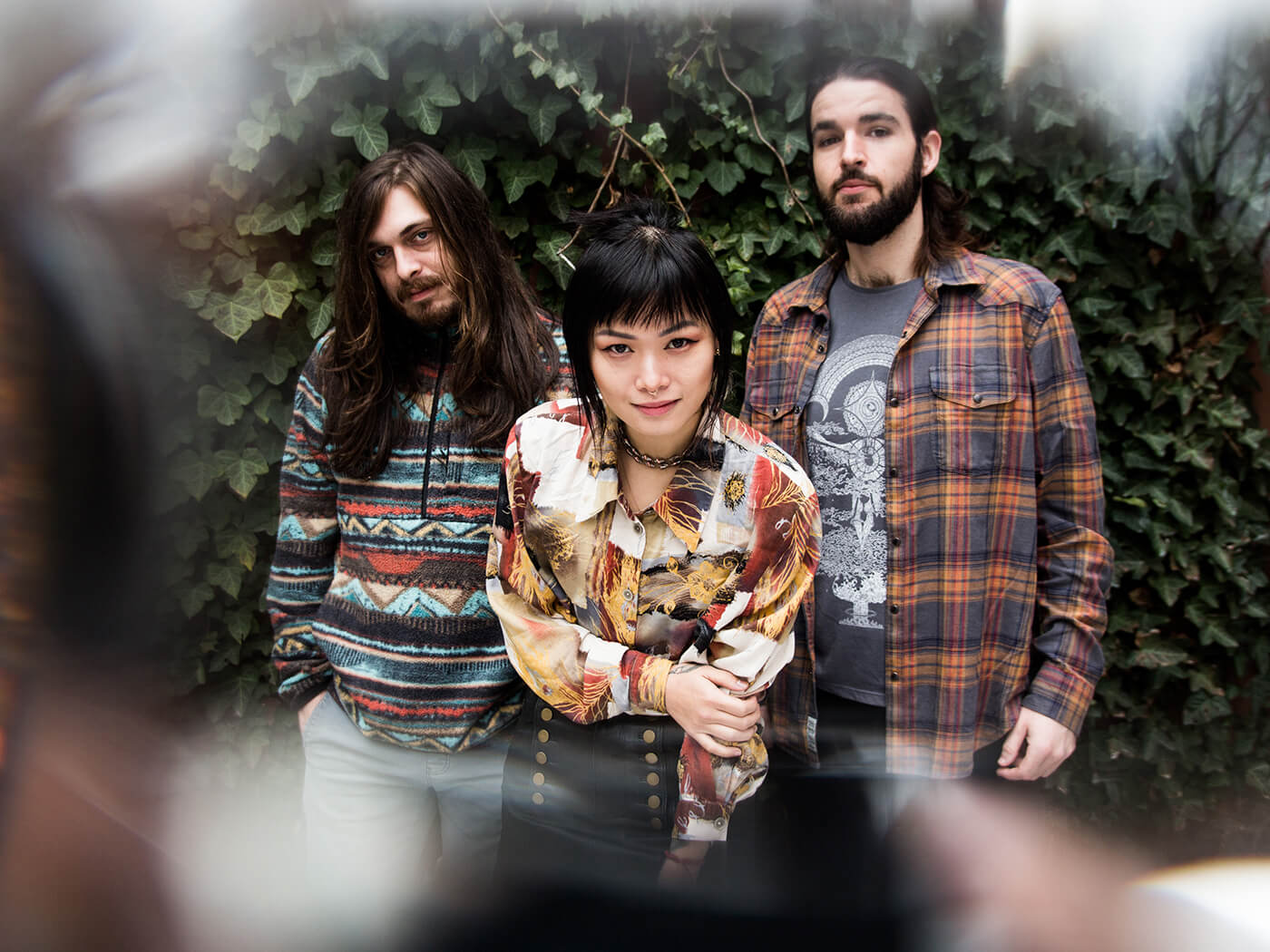“I picked up the guitar when I was really sick in the hospital”: Covet’s Yvette Young
The Californian band’s new LP fuses math-rock, post-rock, prog and jazz, with Yvette Young��’s breathtaking technique always centre-stage. She tells us how the guitar saved her and sings praises of her new signature Ibanez Talman.

Covet get their heads together (clockwise from top): Forrest Rice, Yvette Young & David Adamiak
Music is medicine for Yvette Young, but it hasn’t always been an easy path. The Californian virtuoso started out with classical piano and violin from the age of four, but by the time she was in high school, the pressure of orchestra life and playing piano competitively had driven her to a dark place – she ended up in hospital after a stress-related breakdown and eating disorder led to a heart problem. But in that bleak moment, Young discovered the guitar. Teaching herself to play from her hospital bed, Young began to develop her remarkable tapping guitar style, while also discovering a healthy and positive creative outlet for her talents.
This aspect of her relationship with the guitar came to the fore as Young stared down the barrel of a looming deadline to finish Technicolor, the second album for her math-rock band Covet. Once again Young found herself dogged by difficult personal circumstances, and again it was the guitar that provided a cathartic route out.
“It was all such a blur and I was going through something difficult at the time,” she tells us from her home in San Francisco’s Bay Area. “Writing Technicolor was difficult because I wasn’t in the mindset for it, and was pretty bummed out, but making this album brought me out of it. I wanted to make music that conveyed how I wished I felt, music that was uplifting, optimistic and comforting.
“Everything I put out is supercharged with emotion because music and emotion are so linked for me. Every time I write any sort of song, I want it to tell a story, paint a mood or a scene. I picked up the guitar when I was really sick in the hospital and it was important for me to have something that I didn’t associate with pressure or stress. Even after I left the hospital, the guitar has stayed my primary emotional outlet. That’s what keeps me writing music, I’m chasing an emotion or a melody that I hear.”
No parachute
Watching Young in full flight is a stirring sight, whether she’s playing solo online or being the driving force behind Covet. It’s the latter where you feel her truly take flight – her wonderfully musical and deft two-handed tapping style electrifying the band’s blend of math-rock, prog, post-rock, jazzy flourishes and complex time signatures
It’s remarkable just what an emotionally uplifting journey Technicolor is for a largely instrumental record. Right from the first note of opener Good Morning, as glacial reverb-bathed tones teeter on the edge of breakup, its capacious, colourful textures ebb and flow. Backed by the understated work of bassist David Adamiak, tremolo picking, alternate tunings and complex fingerstyle parts weave mesmerically in and out of drummer Forrest Rice’s skittering patterns. Unlike their 2018 debut, Effloresce, however, Technicolor isn’t a purely instrumental record – on Farewell and the aptly titled Parachute, Young takes a vocal for the first time.

“The most marked difference is there are vocals on two songs – or 2.5 as I do a couple of oohs and ahhs on Odessa,” she laughs. “That’s new for us, we’ve never had vocals before. My whole rule for writing a song is that I don’t rule anything out. If a song needs something, I do it. I’m a slave to the song.
“I wrote Parachute about jumping into the unknown. Sometimes you fall into habits and routines in life and you have to do something to change and it’s scary. I was less scared of singing and more excited. I was anxious, but a good kind of anxious.”
Finding space for her voice – and allowing the expanded arsenal of effects to shine as instruments in their own right – means Young’s intricate playing is at times simplified on Technicolor. Riffs and phrases are given more space to hang tantalisingly in the air. Taking pride of place on Young’s pedalboard, which also features a new signature Z.Vex Lo-Fi Junky, are an optical compressor and not one but two chorus pedals.
“We went even further with effects,” she says, “there’s very little truly clean guitar tone on the album. A lot of the songs are less ‘notey’. There are still a lot of notes, but on a song like Odessa for instance, I really wanted melody to be the driving force. Sometimes effects don’t really shine if you’re playing too much.
“I was really sick and it was important for me to have something that I didn’t associate with pressure or stress. Even after I left the hospital, the guitar has stayed my primary emotional outlet”
“The heavy hitters on the album were my Earthquaker Devices Warden compressor, which I used a lot to shape my clean tone. There’s a sustain knob that you can max out to get yourself to break up more, so that knob was responsible for a lot of the slightly broken-up clean tones.
“The Electronic Audio Experiments Longsword was the only gain pedal on the entire record, then I used two choruses – a Somersault Lo-Fi Modulator from Caroline Guitar Company, which is responsible for the really lo-fi fluttery tape warble sounds, and the Julia from Walrus Audio, that’s responsible for the more traditional chorus sounds. The main reverb pedal I used was the Mercury Seven from Meris. There’s a pitch down vector and every time you hear a pitch that plummets, that’s the Mercury Seven adding some epicness to the part. It’s all over Nero.
“I used the Earthquaker Devices Avalanche Run, which has that really cool swell feature that delays the attack of your note and the Carbon Copy Deluxe, which is such a nice-sounding analogue delay, the repeats have a lot of character.”

Talman syndrome
One signature aspect of Young’s gear arsenal has remained constant, however, and that’s her enduring love affair with one of Ibanez’s most under-appreciated original designs – the Talman. Having started out life as a T-type player – a $90 SX Tele clone with Bill Lawrence pickups – Young discovered the vaguely offset double-cut when she began working with Ibanez, ripping the pickups from her original T-style and getting them installed in a pink sparkle Prestige model that soon became her hallmark. She would later migrate to a sunburst model sporting three S-type Seymour Duncan Five Two pickups, before finally becoming the proud owner of her own signature version at NAMM 2020 – the Slime Green Sparkle YY10.
Young is remarkably just the second female guitarist to get an Ibanez signature, and also just the second artist to have a Talman with their name on the headstock (joining The Offspring guitarist Noodles), but when we ask her about the YY10, the first thing she gushes about are those Seymour Duncan pickups
“I love those pickups,” she enthuses. “My whole spiel about pickups is, you can have a guitar that looks amazing and feels good, but if it sounds not that great you won’t pick it up because you won’t feel inspired. The first time I picked up a guitar with the Five Two set in, the Sunburst Talman, I was so inspired. I wrote so much music on it, they ended up giving it to me. Right out of the box, you can just plug the Talman into the amp with no compression, it plays really smoothly, it’s nice and clean, but if you dig in it can break up really well, and it interacts really nicely with my AC10.
It’s clearly a combo that she found inspirational – other than a fleeting appearance from a custom Ibanez FR Series 7-string on the song Aries, the YY10 going into that “pride and joy” white Vox AC10 is the sound of the entire record, providing the secret to her trademark ‘edge of breakup’ tone.
“The neck feels really good, too, it’s a Custom Shop neck,” she continues. “The Duncans are really good for clean tone and pedals. I really like when I adjust my tone to be a little bit of breakup, just on the border of being distorted, but when I lay back it’s clean. It sounds really good with delays, too, there’s something about that extra bit of gain where it makes the repeats have so much character and emphasises them.”
Keep it varied
While the gear plays its part, the root of Young’s wonderfully expressive and creative playing style is by her own admission a product of her early mastery of other instruments. It’s a musical multilingualism that has also helped her circumvent the established conventions of traditional guitar playing.
“I think playing other instruments changes how I think about things harmonically and polyphonically,” she explains. “In piano, you have to think about your accompaniment as well as your main line. I think I play the fretboard kind of like I play a piano, in that my left hand and the lower strings are like the accompaniment and my right hand is the lead line.
“With violin, it just got my ear really sensitive to intonation and pitch and muscle memory. You don’t know the joys of muscle memory until you play a fretless instrument! “I never consciously thought, ‘I want to escape the rules of the guitar’. For me, guitar is really important because there are a lot of rules in the classical world and pressure to be perfect and compete. I just wanted to escape that world and have something for myself.”
Having something for herself meant starting out as a solo artist and recording pedal demo videos. Young learnt quickly how to fill the space in her songs. She admits to being influenced more by composers and songwriters such as Ryuichi Sakamoto and Sufjan Stevens than guitarists, although she has a long-standing admiration of another virtuoso player, Guthrie Govan.
“I never set out to be ‘the tapping girl’,” she affirms. “It’s just something that ended up happening because of the other instrument I was playing. When I taught myself tapping, it was like ‘Oh you can do this thing’, and I started using it a lot because it was easy for me because of the piano. I never used a pick, because it felt like a weird extension of my body and it never felt quite right.
“I always had to play by myself, so my challenge was, how do I sound as full as I can as one person? Fingerstyle and tapping helped me achieve that. The reason why these days I lay back more is I’m writing with a band and realising it’s nice to leave space for other people in my band to fill out the sound.
“I developed my style by playing alone, but I’m adapting how I play to fit the sound of the band. Our rule is whatever serves the music. You don’t want to be stepping on each other. I think it’s important for them to write their own parts because I want them to be invested in it.”

It’s an important distinction – rather than being a virtuoso guitarist, and now singer, backed by a pair of willing session musicians, Covet are a real band, and while Young has been using the COVID-19 lockdown to work on acoustic and piano-led songs for her solo project, her focus is on the three-piece. When we reflect on the journey they’ve taken over the past two years, she laughs in disbelief.
“It’s almost insane,” she says. “I never thought any of this would happen. I started the band with David to have fun and we jammed in a garage. I never imagined we’d be at a studio, on a label and touring. I never thought I’d quit my job because this takes up so much of my time. It’s a privilege. I never lusted after it, it’s not something that was my dream, but it seems like I was really fortunate to have this opportunity handed to me. When I think about how lucky that is, it makes me want to work really hard. I want to feel like I deserve it.”
Covet’s new album Technicolor is out now on Triple Crown Records.
